#gallic mythology
Text
The gods of Gaul: Introduction, or why it is so hard to find anything
As I announced, I open today a series of post covering what some can call the "Gaulish mythology": the gods and deities of Ancient Gaul. (Personal decision, I will try avoiding using the English adjective "Gaulish" because... I just do not like it. It sounds wrong. In French we have the adjectif "Gaulois" but "Gaulish"... sounds like ghoulish or garrish, no thank you. I'll use "of Gaul", much more poetic)
[EDIT: I have just found out one can use "Gallic" as a legitimate adjective in English and I am so happy because I much prefer this word to "Gaulish", so I'll be using Gallic from now on!]
If you are French, you are bound to have heard of them one way or another. Sure, we got the Greek and Roman gods coming from the South and covering up the land in temples and statues ; and sure we had some Germanic deities walking over the rivers and mountains from the North-East to leave holiday traditions and folk-beliefs... But the oldest gods of France, the true Antiquity of France, was Gaul. And then the Roman Gaul, and that's already where the problems start.
The mythology of Gaul is one of the various branches of the wide group known as Celtic mythology or Celtic gods. When it comes to Celtic deities, the most famous are those of the British Isles, due to being much more preserved (though heavily Christianized) - the gods of Ireland and the Welsh gods are typically the gods every know about when talking about Celtic deities. But there were Celts on the mainland, continental Celts - and Gaul was one of the most important group of continental Celts. So were their gods.
Then... why does nobody know anything about them?
This is what this introduction is about: how hard it actually is to reconstruct the religion of Gaul and understand its gods. Heck we can't ACTUALLY speak of a Gaulish mythology because... we have no myth! We have not preserved any full myth or complete legend from Ancient Gaul. The pantheon of Gaul is the Celtic pantheon we probably know the least about...
Why? A few reasons.
Reason number one, and the most important: We have no record of what the Gauls believed. Or almost none. Because the people of Gaul did not write their religion.
This is the biggest obstacle in the research for the gods of Gaul. It was known that the art of writing was, in the society of Gaul, an elite art that was not for the common folks and used only for very important occasions. The druids were the ones who knew how to read and write, and they kept this prerogative - it was something the upper-class (nobility, rulers) could know, but not always. Writing was considered something powerful, sacred and magical not to be used recklessly or carelessly. As a result, the culture of Gaul was a heavily oral one, and their religion and myths were preserved in an oral fashion. Resulting in a great lack of written sources comng directly from the Gallic tribes... We do have written and engraved fragments, but they are pieces of a puzzle we need to reconstruct. We have votive offerings with prayers and demands inscribed on it - and while they can give us the names of some deities, they don't explain much about them. We have sculptures and visual representations of the deities on pillars and cups and jewels and cauldrons - but they are just visuals and symbols without names. We have calendars - but again, these are just fragments. We have names and images, and we need to make sense out of it all.
To try to find the explanations behind these fragments, comparisons to other Celtic religions and mythologies are of course needed - since they are all branches of a same tree. The same way Germanic mythology can be understood by looking at the Norse one, the same way Etruscan, Greek and Roman mythologies answer each other, the mythology and religion of Gaul has echoes with the Celtic deities of the Isles (though staying quite different from each other). The other comparison needed to put things back into context is reason number 2...
Reason number two: The Romans were there.
Everybody knows that the death of Ancient Gaul was the Roman Empire. Every French student learns the date of Alesia, the battle that symbolized the Roman victory over the Gallic forces. Gaul was conquered by the Romans and became one of the most famous and important provinces of the Roman Empire: it was the Gallo-Roman era.
The Romans were FASCINATED by Gaul. Really. They couldn't stop writing about them, in either admiration or hate. As a result, since we lack direct Gallic sources, most of what we know about Ancient Gaul comes from the Romans. And you can guess why it is a problem. Some records of their religion were written in hatred - after all, they were the barbarian ennemies that Romans were fighting against and needed to dominate. As such, they contain several elements that can be put in doubt (notably numerous references to brutal and violent human sacrifices - real depictions of blood-cults, or exaggeratons and inventions to depict the gods of Gaul as demonic monstrosities?) But even the positive and admirative, or neutral, records are biased because Romans kept comparing the religion of the Gauls to their own, and using the names of Roman deities to designate the gods of Gaul...
Leading to the other big problem when studying the gods of Gaul: the Roman syncretism. The Gallo-Roman era saw a boom in the depictions and representations of the Gallic gods... But in their syncretized form, fused with and assimilated to the Roman gods. As such we have lots of representations and descriptions of the "Jupiter of Gaul", of the "Mercury of Gaul", of the "Gallic Mars" or "Gallic Minerva". But it is extremely hard to identify what was imported Roman elements, what was a pure Gallic element under a Roman name, and what was born of the fusion of Gallic and Roman traditions...
Finally, reason number three: Gaul itself had a very complicated approach to its own gods.
We know there are "pan-gallic" gods, as in gods that were respected and honored by ALL the people of Gaul, forming the cohesion of the nation. But... Gaul wasn't actually a nation. It was very much like the many city-states of Greece: Ancient Gaul was unified by common traditions, a common society, a common religion and a common language... But Gaul was a tribal area divided into tribes, clans and villages, each with their own variations on the laws, each with their own customs and each with their own spin on religion. As a result, while there are a handful of "great gods" common to all the communities of Gaul, there are hundreds and hundreds of local gods that only existed in a specific area or around a specific town ; and given there were also many local twists and spins on the "great gods", it becomes extremely hard to know which divine name is a local deity, a great-common god, a local variation on a deity, or just a common nickname shared by different deities... If you find a local god, it can be indeed a local, unique deity ; or it can be an alternate identity of a shared divine archetype ; or it can be a god we know elsewhere but that goes by a different name here.
To tell you how fragmented Gaul was: Gaul was never a unified nation with one king or ruler. The greatest and largest division you can make identifies three Gauls. Cisalpine Gaul, the Gaul located in Northern Italy, conquered by the Romans in the second century BCE, and thus known as "the Gaul in toga" for being the most Roman of the three. Then there was the "Gaul in breeches" (la Gaule en braies), which borders the Mediterranean sea, spanning between the Alps and the Pyrenean mountains, and which was conquered in the 117 BCE (becoming the province of Narbonne). And finally the "Hairy Gaul", which stayed an independant territory until Cesar conquered it. And the Hairy Gaul itself was divided into three great areas each very different from each other: the Aquitaine Gaul, located south of the Garonne ; the Celtic Gaul located between the Garonne and the Marne (became the Gaul of Lyon after the Roman conquest) ; and finally the Belgian Gaul, located between the Marne and the Rhine. And this all is the largest division you can make, not counting all the smaller clans and tribes in which each area was divided. And all offering just as many local gods or local facets of a god...
And if it wasn't hard enough: given all the sculptures and visuals depictions of the gods of Gaul are very "late" in the context of the history of Gaul... It seems that the gods of Gaul were originally "abstract" or at least not depicted in any concrete form, and that it was only in a late development, shortly before the Roman invasions, that people of Gaul decided to offer engravings and statues to their gods, alternating between humanoid and animal forms.
All of this put together explains why the gods of Gaul are so mysterious today.
177 notes
·
View notes
Text
Ending today with the Celts and the Kahina, so a brief look at some Celtic mythical archetypes first:
Ending today with a look at Celtic women in history and myth and then the Kahina, as a nod to tomorrow and the history of early Islam. First up is the Gallic Goddess Epona, who has a mirror in the British Rhiannon. Both Epona and Rhiannon were deities associated with horses, travel, and speed. Epona is also attested in plenty of Roman writings and has enough of her myth and her understanding to be fully discussed as a deity in more than a speculative sense.
In a good example of how different cultures can see an entity that might have had the same origin in different lines, Epona of the Gauls was a celibate deity, Rhiannon of the Britons was very much not.
#lightdancer comments on history#lightdancer comments on literature#women's history month#classical world and women's history#gallic mythology#epona#the goddess in theory and practice
1 note
·
View note
Text




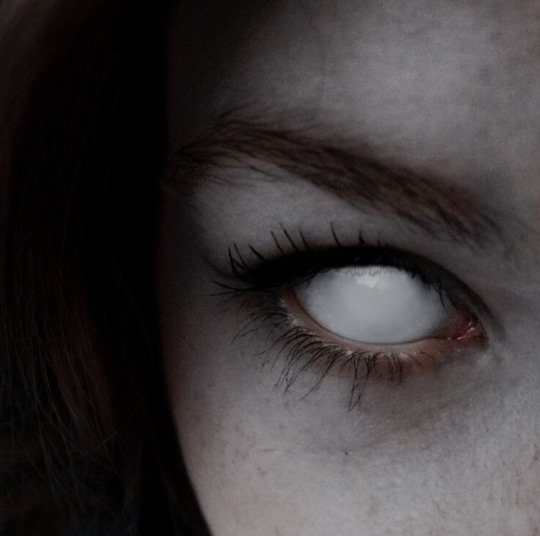
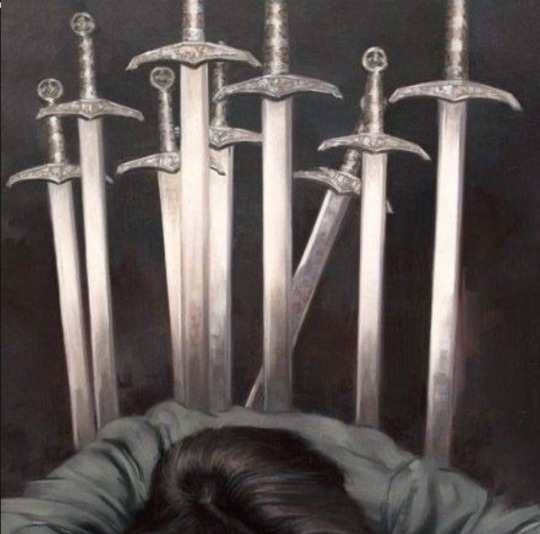


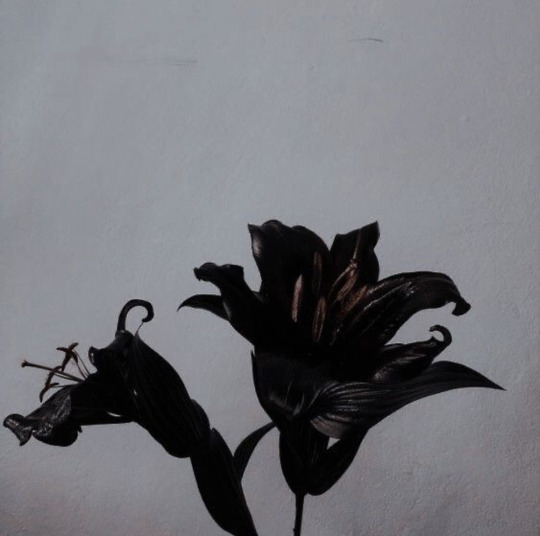
Adsaxsona: "Weaver of Spells" and Gaulish goddess of the Underworld, witches, revenge, justice, and magick.
#adsagsona#Adsaxsona#pagan#deities#polytheism#polytheist#deity#paganism#gaul#gallic gods#gaulish paganism#gallo roman#gaulish#Hecate#celtic pagan#celtic pantheon#celtic mythology#devotional moodboard#moodboard
10 notes
·
View notes
Text
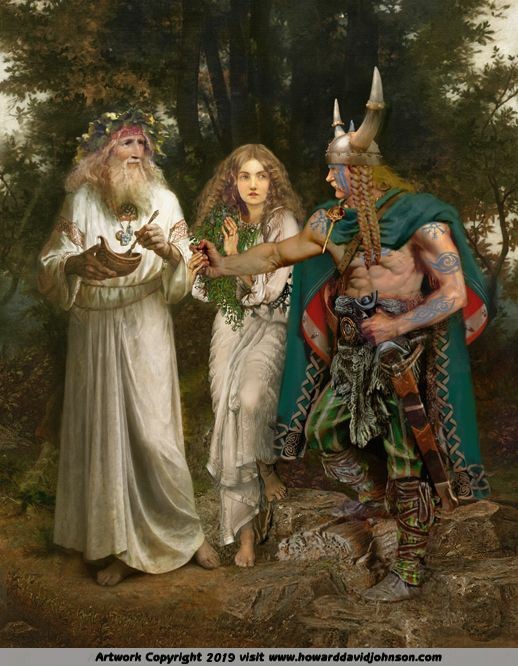
Druid, Druidess and Gallic Warrior painting by Howard David Johnson
#druid#druidess#celtic mythology#druidry#druidic#paganism#celtic paganism#hedge druid#gallic warrior
79 notes
·
View notes
Text

The sultry 1969 hit single Je T’aime … Moi Non Plus was a four-and-a-half-minute distillation of languid Gallic cool, in which a Frenchman, his voice coarsened by Gitanes, is heard billing and cooing with an ecstatically sighing young Englishwoman over the swirling motif of a baroque organ. That man was Serge Gainsbourg; his companion was Jane Birkin, the actor and singer, who has died aged 76. Though Birkin worked with some of the world’s finest film-makers, including Jacques Rivette and Agnès Varda, she knew that Je T’aime … would be remembered above everything else she did. “When I die, that’ll be the tune they play, as I go out feet first,” she said.
Birkin was 21 when she and Gainsbourg met while starring together in the film Slogan (1969). He was 40, and had previously recorded Je T’aime … as a duet with Brigitte Bardot, only for the actor to withdraw permission for it to be released. Birkin had already starred in a 1965 musical, Passion Flower Hotel, scored by John Barry, whom she married that year at the age of 19 and from whom she was divorced in 1968; he was the father of Kate, the first of Birkin’s three daughters. But it was on the duet with Gainsbourg, she said, that for the first time “somebody thought I had a pretty voice”.
She sang her part an octave higher than Bardot. “It gave it a choirboy side that [Gainsbourg] liked a lot,” she said. Rumor's that the vocal track was recorded under the covers during a moment of intimacy were untrue (the couple were standing at separate microphones in a studio in central London) though they did nothing to harm the mythology surrounding a song that was later condemned by the Vatican. “I just remember thinking it was all terribly funny,” she said.
Among the countries that refused to give the song airplay was Britain, where it became the first banned single to reach the top of the charts, as well as the first non-English-language No 1. It was also the lead track on the 1969 album Jane Birkin/Serge Gainsbourg.
Birkin’s life remained inextricably linked to his. They were together for 11 years, and had a daughter, Charlotte, who became a successful singer and actor. Even after they separated in 1980, he continued to write for her, and she went on performing his songs for the rest of her life.
Far from being an adjunct to Gainsbourg’s legend, she possessed her own style, intelligence and attitude. Her wistful beauty was rendered unorthodox by an eager, gap-toothed smile. Her voice was as bewitching as her face: though she lived in France from 1969 onwards, and spoke French fluently, she never shed her breathy, crisply English accent.
She was born in London to Judy Campbell, an actor who had been a muse to Noël Coward, and David Birkin, who was a lieutenant commander in the Royal Navy and a spy during the second world war. His duties included taking British spies across the Channel to France and bringing back stranded airmen and escaped prisoners of war.
Jane was educated at Upper Chine school on the Isle of Wight. At 17 she starred with Ralph Richardson in Graham Greene’s play Carving a Statue; Greene himself had a hand in casting her. Her screen acting career began with a walk-on part in The Knack … and How to Get It (1965) and a controversial nude scene in Michelangelo Antonioni’s Blow-Up, which she agreed to because Barry had told her she wouldn’t dare.
She had a small role in the Warren Beatty caper Kaleidoscope (also 1966), played a model called Penny Lane in the psychedelic curiosity Wonderwall (1968) and starred with Romy Schneider and Alain Delon in the psychological thriller La Piscine (1969). She got on famously with Bardot when they starred together in Don Juan, or If Don Juan Were a Woman (1973). Gainsbourg directed her in a 1976 film named after their hit song; he cast her as a boyish woman who attracts the attentions of a gay man, played by the Warhol regular Joe Dallesandro.
Birkin was tremendous fun in two star-studded Agatha Christie thrillers, Death on the Nile (1978) and Evil Under the Sun (1982). In the cryptic Love on the Ground (1984), Rivette cast her and Geraldine Chaplin as actors drawn into a playwright’s mysterious world. She appeared in two films, The Pirate (1984) and Comedy! (1987), made by her then partner, Jacques Doillon, with whom she had her third daughter, Lou, also a singer and actor. Jean-Luc Godard directed her in Keep Your Right Up (also 1987), while for Varda she played a woman besotted with a 14-year-old boy in Kung-Fu Master! (1988); the film co-starred Charlotte and featured Lou, and was inspired by an idea by Birkin herself.
In the same year, Varda made her the subject of Jane B For Agnès V, in which the actor performed a variety of specially scripted scenes (in one, she was a Stan Laurel type, in another a cockney mother) interspersed with musings on her life. She received the documentary treatment once again when her daughter directed Jane By Charlotte (2021).
Her two most impressive performances came in Bertrand Tavernier’s These Foolish Things, aka Daddy Nostalgie (1990), in which she was moving as a woman trying to repair her relationship with her dying father (Dirk Bogarde); and La Belle Noiseuse (1991), Rivette’s spellbinding four-hour study of a painter (Michel Piccoli) and his new muse (Emmanuelle Béart), in which Birkin played the artist’s wife and former model, who must deal with the indignity of having her younger self literally painted over.
Later films included Alain Resnais’s musical On Connaît la Chanson (1997) and the Merchant-Ivory coming-of-age story A Soldier’s Daughter Never Cries (1998).
In 2002 Birkin was diagnosed with leukaemia, but by 2006 she had made her directorial debut with the autobiographical family drama Boxes, which she also wrote and starred in, along with Chaplin, Piccoli, John Hurt and her daughter Lou. She appeared in Rivette’s final film, Around a Small Mountain (2009), played herself in Hong Sang-soo’s Nobody’s Daughter Haewon, and was reunited with Tavernier for his comedy The French Minister (also 2013).
Her look had been widely applauded in the 1960s, and seemed never to go out of date. In the 80s Hermès introduced a large and exorbitantly priced leather bag, named “the Birkin” in her honour. Fashion journalists in recent years could still be heard celebrating the “Jane Birkin top”, referring to the white lace dress made famous by her in the late 60s. “Real life was what I was best at,” she told Vogue magazine in 2016. “I didn’t have confidence in movie cameras or on stage. But I did have confidence in what I wanted in real life. If I wanted to be barefoot and wear a mackintosh, I would do it. I didn’t give a hoot.”
It was at 40 that she finally discarded her youthful ingénue image and performed her first live concert: “I cut my hair off like a boy, I wore men’s clothes. I only wanted people to hear the music and words. It was fantastic. And it was so frightening. Serge was there and he kept lighting his cigarette lighter to make everybody put their lighters on.” That show was preserved on her 1987 album, Jane Birkin au Bataclan. She continued singing and recording into her old age; among her later albums is Birkin/Gainsbourg: Le Symphonique, from 2017, in which the couple’s songs received new orchestral arrangements.
In 2020 she published Munkey Diaries 1957-1982, containing diary entries addressed to her favourite cuddly toy from childhood, which she can be seen clutching on the cover of Gainsbourg’s 1971 album Histoire de Melody Nelson. She buried the toy with him after his death in 1991.
She is survived by Charlotte and Lou, and six grandchildren, and by her brother, Andrew, and sister, Linda. Kate, a photographer, died in 2013.
🔔 Jane Mallory Birkin, actor and singer, born 14 December 1946; died 16 July 2023
Daily inspiration. Discover more photos at http://justforbooks.tumblr.com
84 notes
·
View notes
Text

IF YOU ARE READING THIS, THAN YOU HAVE FOUND HER.
BEHOLD ABUNDANTIA,THE GOOD GODDESS. WEALTH, ABUNDANCE,BOUNTIFULNESS, RICHNESS, FORTUNE.

In Roman religion, Abundantia was the personification of prosperity and abundance. She was a beautiful goddess who was known for bringing grain and money in a cornucopia to the mortals as they slept. Let’s take a closer look at the goddess and the role she played in Roman mythology.
Abundantia’s parentage is unknown as there are hardly any records about the goddess. What is known is that she presided over the flow of money, valuables, fortune, prosperity and success. Her name was derived from the word ‘abundantis’ which means riches or plenty in Latin.
Abundantia was almost always depicted with a cornucopia over her shoulder. The cornucopia, also known as the ‘horn of plenty’, is a symbol closely associated with the goddess and signifies what she stands for: abundance and prosperity. Sometimes her cornucopia contains fruit but at other times it carries gold coins, which magically spill out of it.
Some sources say that Abundantia was a vision of exceptional beauty and purity. Just like she was beautiful on the outside, she was also beautiful on the inside. She was a lovely, patient and kind goddess who took pleasure in helping people and was very generous with her gifts.
In Greece, Abundantia was identified with Eirene, the goddess of wealth and prosperity. She was also often identified with the Gallic goddess of prosperity, known as Rosmerta. The goddess was also popular among gamblers who called her ‘Lady Fortune’ or ‘Lady Luck’.
The Romans believed that their deities took control of everything that went on in their lives and, just like in Greek mythology, every task and occupation had a Roman god or goddess presiding over it.
Abundantia’s role was to help mortals with everything related to money and financial success. She would help people to make major purchases, influencing and guiding them to protect their investments and savings and to wisely handle their finances.
The goddess also had the power to remove all the concerns and worries that people had about money. This was useful since she helped eliminate negativity in their lives due to financial worries. In this way, she not only brought them wealth and prosperity, but she also brought them success and good fortune. Her cornucopia was said to be filled with coins and grain which she would occasionally leave at people’s doorsteps as a little gift.
According to Ovid, the Augustan poet, Abundantia featured in the myth of the river god Achelous. The legendary Greek hero, Heracles, had defeated Achelous by ripping off one of his horns. The Naiads, who were nymphs in Greek mythology, took the horn and turned it into a Cornucopia and gifted it to Abundantia to use. This is only one version of the Cornucopia’s origin but there are many other myths that provide various explanations.
In some accounts, the Cornucopia was said to be a horn of Amaltheia, the mystical she-goat which Jupiter, the god of the sky, broke off by accient. To comfort Amaltheia, Jupiter caused it to keep refilling itself with food and drink. Later, the horn went into the hands of Abundantia but how it happened isn’t exactly clear. Some say that Jupiter gifted it to her to use.

THE WORSHIP OF ABUNDANCE
As a minor goddess, there were very few temples that were specifically dedicated to Abundantia. The Romans worshipped her by making offerings and praying to her. Their offerings included milk, honey, fruit, flowers, grain and wine and they also sacrificed birds and animals in her name. In Roman religion, the gender of the sacrificed animal was supposed to correspond to the gender of the deity to whom the animal was being offered. Because of this, sacrifices that were made to Abundantia were a cow, heifer, female bird, sow or a white ewe.
Abundantia was a minor goddess in Roman mythology, but she was one of the most loved deities of the Roman pantheon. The Ancient Romans revered her because they believed she eased their worries and helped them in their times of financial difficulty.
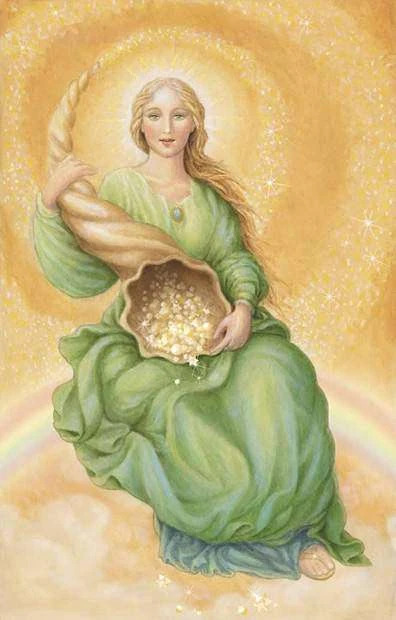
HER IMAGE
The goddess of abundance and prosperity was depicted on Roman coins that were issued in the 3rd century CE. On the coins, she’s portrayed seated on a chair with her famous symbols, the Cornucopia, which she holds or tips over slightly to make the riches pour out. She’s sometimes depicted on coins with ears of wheat and at other times, she stands on a ship’s prow, representing the Roman Empire’s overseas conquests.

IF YOU ARE A HEATHEN OR A HEDONIST OF A PURE HEART, OR CAN APPROACH THIS GODDESS WITH THE SAME LEVEL OF LOVE, RESPECT, AND COMPASSION AS YOU WOULD A LOVING CARING MOTHER, YOU CAN DEFINITELY COUNT ON HER TO LEAN ON FOR SUPPORT. YOU YOU ARE SEEKING GREATER WEALTH OR ARE INVOLVED IN FEEDERISM AND SEEKING TO BETTER PROVIDE AND STOCK UO ON FOOD, SHES YOUR GODDESS, SO LONG AS YOUR A GOOD PERSON AT HEART THAT IS.
#hedonism#abundantia#roman goddess#roman religion#paganism#prayforturkey#cornucopia#bountiful#fruitful#mother goddess#luxury#minor gods#gay feederism#plentiful#prosperity#wealth#hellenic pagan#gluttnous#royalty
35 notes
·
View notes
Text
OC + Random Associations
tagged by @cetra, thank you lovely!!
tagging @avallachs @habit @kirnet @astarien @wrymbloods @dekarios @alexios @calenhads @dekariosgale and anyone else who wants to do this

Animal: Elk. Stags that are antler locked with one another.
Colors: Green, brown, muted reds
Month: January
Songs: April to Death by Flower Face, Station Waggin by Pretty Balanced, Here I Dreamt I Was an Architect by The Decemberists
Number: 17
Plants: Rabbits foot fern
Smells: Leather, campfire, musk lol
Gemstone: Leopard skin jasper
Time of day: Sunrise
Season: Autumn
Places: Alleyways lit by fire lanterns, a dry forest,
Food: Stew
Drinks: Ale
Element: Earth
Seasonings: Bay Leaves
Sky: Overcast but not foggy or rainy, just cloudy
Weather: Crisp chill
Magical power: I suppose super strength??
Weapons: Greatsword
Candy: Toffee
Method of long distance travel: Wagon
Artstyle: Hellenistic (Boxer of the Quirinal, The Dying Gaul/Dying Gallic Trumpeter, Nike of Samothrace............. Faun Barberini..............)
Fear: Losing control
Mythological creature: Minotaur
Piece of stationary: Sheep parchment
Three Emojis: 🦌⚔️🌱
Celestial body: Jupiter

Animal: California Condor
Colors: Black, red, gold
Month: August
Songs: I'm Your Man by Mitski
Number: 6
Plants: Venus Fly Trap
Smells: Wine, apples, patchouli, frankincense
Gemstone: Smoky quartz
Time of day: Midnight
Season: Summer
Places: Banquet halls, ball rooms, a stage, the House of Hope
Food: Pig roast, pomegranates
Drinks: Wine
Element: Fire
Seasonings: Basil
Sky: Sunset
Weather: Dry and hot
Magical power: Shapeshifting
Weapons: A bow, with both gold and lead tipped arrows :)
Candy: Orange chocolate
Method of long distance travel: Flight
Artstyle: Academism and Italian Baroque
Fear: Never being free
Mythological creature: Scylla
Piece of stationary: Quill
Three Emojis: 🍎🔥⚜️
Celestial body: A moon
#i did two ocs... i wasnt sure if there was a limit and i felt like it so <3#also as always idk who likes to be tagged so if i tagged you and you dont want to be tagged#lmk!#if i didnt tag you and you want to be tagged#also lmk!#i will!#oc: callesian#oc: helios
11 notes
·
View notes
Text
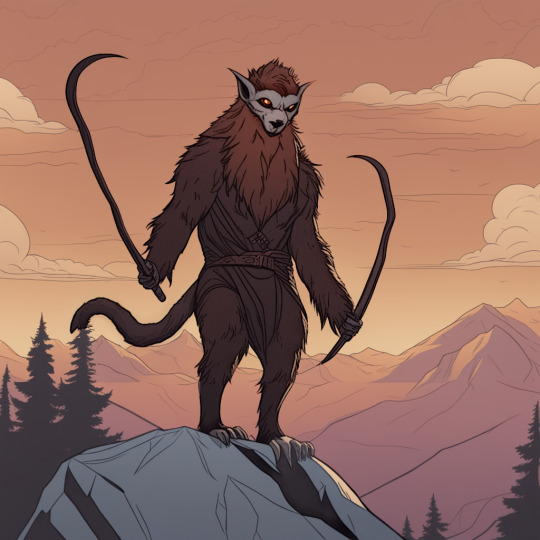
The Orc
The Orc, natively known as Orgg or Lorgg is a mountain demon, which is feared by the peoples of the Alps. In the Early Middle Ages, the Celto-Roman god Orcus, like many other pagan figures, was downgraded to a simple creature of Alpine Mythology, serving here as a demon punishing human actions often as a protector of animal life, but other times its actions are just of pure evil.
Appearance
The Orc, in its various manifestations, exhibits a curious blend of humanoid and animalistic characteristics. It is often described as having a head resembling that of a large dog, bear-like fur, a broad mouth with iron teeth, and a snake-like tail. Its eyes are said to emit a fiery glow, adding to its eerie presence. Also, it has disproportionately long arms, allowing it to reach far and wide, and its razor-sharp claws, resembling those found on scavenging vultures.
Despite its animal-like appearance, the Orc is quite proficient in using tools and weapons. It is frequently portrayed wielding scythes with skill and precision.
Behaviour
The Orc is a complex figure in Alpine mythology, with its actions and intentions varying across different narratives. It can be a playful trickster. In some tales, it revels in pranks and mischief, bringing perplexity and laughter to its encounters. The Orc also appears as a guardian of the forest or as the lord of animals, warning wild animals of hunters, or as a demonic herdsman aiding livestock.
However, the Orc also possesses a darker side. It can transform into a menacing presence, attempting to harm humans and animals. Stories tell of it appearing suddenly in fields, and using blades like a sharp sickle to injure those who dare to approach and steal from it. It has the ability to hide everywhere only emitting eerie whistles or bird-like calls, and it strikes with swift and frightening agility. Sometimes it can also be heard singing songs like:
"Sharpen, sharpen good, and cut through the legs as through wood!"
Origin
In Roman mythology, Orcus served as an alternative name for deities like Pluto, Hades, or Dis Pater, all associated with the realm of the dead. Orcus specifically denoted the darker aspect of these gods, responsible for the punishment of sinners in the afterlife. The origins of Orcus likely traces back to Etruscan religious beliefs. Additionally, Orcus was a name used to refer to a Gallic god of the underworld. It is unknown wether the Orc is related to another bad spirit known as the Norc.
10 notes
·
View notes
Photo







2,000-Year-Old Graves Found in Ancient Necropolis in Paris
Archaeologists have discovered 50 tombs in an ancient necropolis just meters from a busy train station in central Paris, and these tombs belong to a lost necropolis of the Gallo-Roman city of Lutetia, the predecessor of present-day Paris.
These graves provide a rare look at life in Lutetia, the city that predated Paris by nearly 2,000 years.
Despite numerous road works over the years, as well as the construction of the Port-Royal station on the historic Left Bank in the 1970s, the buried necropolis was never discovered.
Only after plans for a new station exit were announced did France’s National Institute of Preventive Archaeological Research (INRAP) open a series of test trenches covering 200 square meters (2152.78 sq ft) of land around the station.
The excavation revealed burials believed to be part of the Saint Jacques necropolis dating back to the 2nd century, the research institute said in a news release.
Camille Colonna, an anthropologist at INRAP, told a press conference that there were already “strong suspicions” the site was close to Lutetia’s southern necropolis.
The Saint Jacques necropolis, the most important burial site in the Gallo-Roman town of Lutetia, was previously excavated in the 1800s. However, only objects considered precious were taken from the graves, with the many skeletons, burial offerings, and other artifacts abandoned. The necropolis was then covered over and again lost to time.
The INRAP team discovered one section that had never before been excavated.
“No one has seen it since antiquity,” said INRAP president Dominique Garcia.
Colonna also stated that the team was “very happy” to have discovered a skeleton with a coin in its mouth, which allowed them to date the burial to the 2nd century A.D.
The excavation has uncovered 50 graves, all of which were used for burial — not cremation, which was also common at the time.
The remains of the men, women, and children are believed to be Parisii, a Gallic people who lived in Lutetia, from when the town on the banks of the Seine river was under the control of the Roman Empire.
The Parisii were skilled in agriculture, metallurgy, and long-distance trading and lived in the area around the south banks of the Seine River in Paris during the 2nd century AD. The Parisii founded Lutetia (now Paris), and despite fierce resistance to the Roman conquest, they were subjugated in the first century BC.
Ceramic jewelry, hairpins and belts, jug goblets, dishes, glassware, and other grave goods have been recovered to help date the burials. According to INRAP, the positions of hundreds of small iron nails, that attached soles to leather shoes, informed the archaeologists that while some were placed on the feet of the interred, others had been buried with shoes on either side of the bodies as a type of offering.
The entire skeleton of a pig was found inside one coffin, and the remains of another small animal were found inside what is thought to have been a sacrifice pit for the gods. Furthermore, a coin was found lodged inside the mouth of a buried person. The coin, known as “Charon’s obol,” reflected the story of Charon in Greek mythology, in which a coin was given to the ferryman of Hades to transport the souls of the deceased across the river Styx.
INRAP president Dominique Garcia said that the ancient history of Paris was “generally not well known,” adding that the unearthed graves open “a window into the world of Paris during antiquity.”
Unlike the excavation in the 1800s, this time the team plans to remove everything from the necropolis for analysis.
By Leman Altuntaş.


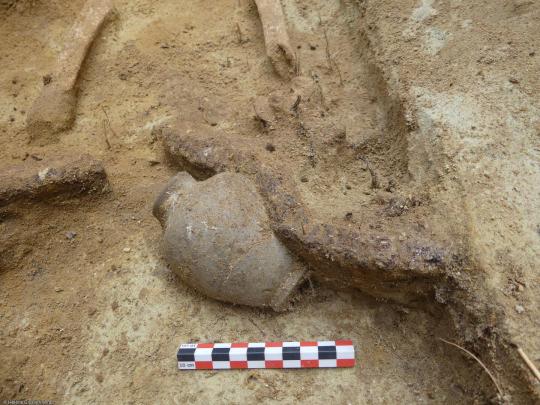
#2000-Year-Old Graves Found in Ancient Necropolis in Paris#ancient grave#ancient tomb#ancient artifacts#archeology#archeolgst#history#history news#ancient history#ancient culture#ancient civilizations#roman history#roman empire
26 notes
·
View notes
Note
If you were to make a miracle box based purely off of Celtic/Gaelic culture, what animals would you put in (also for the sake of this ask let just pretend the Chinese miracle box doesn't exist)?
So, be aware I have not read up a lot about the Celts and anything related to animals if stuff I found by chance when reading around. I'm also not going to cover how it should be set up, I'm just going to mention animals that would be plausible to be there.
Ladybug is promising to be here as I found it's very European oriented in terms of mythology. It is a Christian associated symbol, but across Europe it's also a symbol of romantic love and luck. Plus, you got the official artwork of Tikki associated with a clover, which is a major symbol to Irish culture.

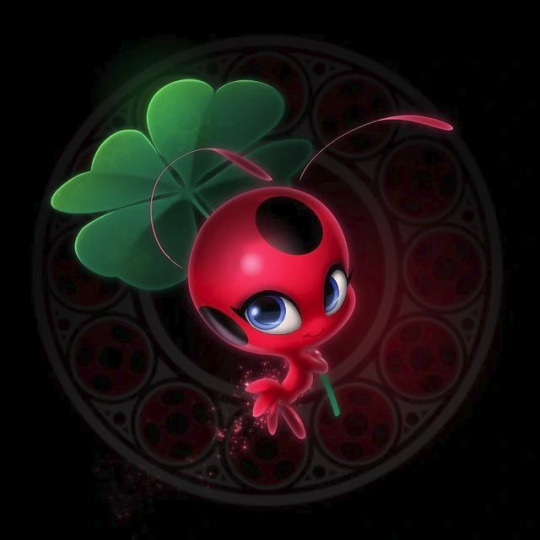
Rooster would be for sure as there's the Gallic rooster, the unofficial symbol of France, which hails from Gaelic origins.

Rabbit would be another, I believe they are tied to the Celtic spring goddess Eostre, which is the potentially inspired origins for the Easter Bunny and why the rabbit is tied to spring. There's also the symbol of the Three Rabbits that has popped up quite a bit in Europe.

Playing off nature being big in Celtic culture, Bee would be plausible to exist, I think they were regarded to have otherworldliness to them. I know in Greece it was thought bees would escort spirits of the dead to the afterlife.
Sheep/Goat is also plausible, especially if you're going with the two being interchangeable. Sheep are especially important to Britain as their wool helps keep people warm, even if they get wet.
As for the possible Celtic Zodiac, they may not be official/fake, but the Celtic Zodiac is promising in animals they have.
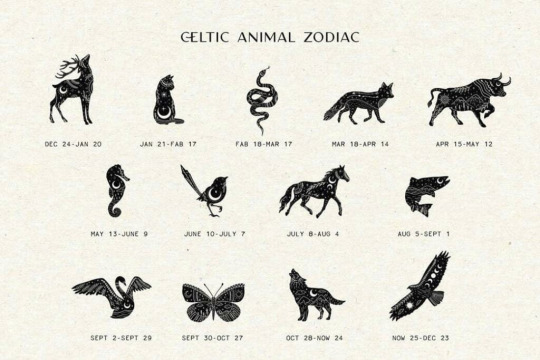
Deer over all is iconic throughout the world in a variety of cultures, and I think the Celts saw it as the Kings of the Forests. There's also the Celtic god Cernunnos, which a hero bearing that name has appeared.
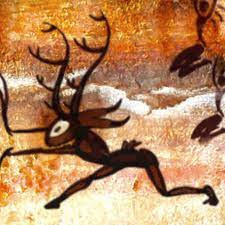
Cats are associated with magic and otherworldliness, and there is fairy cat Cait Sith.

Snakes were a big inspiration for many dragons, Europe included. And I could see tying it to the Celtic Knot with their long body, but I think it was viewed unfavorably so may be better elsewhere.
Fox is very present Europe, I think it was more appreciated and admired for it's cunning and bravery, and it's even a popular fairy tale icon with Reynard the Fox, who was so popular that he changed out the French pronounce fox.
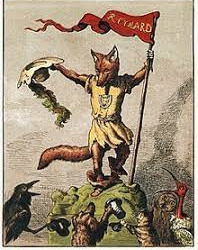
Bulls and cows I've read up are associated with solar and lunar energies and define the personalities differences between the two celestial bodies.
Seahorse can work off a lot of mythical water horses that do appear in Europe (kelpie, hippocampus, Loch Ness is sometimes portrayed as a water horse).
Wrens were thought to be "kings of birds" in Europe.
Horses are major in Europe through knights, with chivalry probably stemming from the word cheval. You can also tie them to the Wild Hunts, which shows up across the world in mythology.
Salmon, there is a Salmon of Knowledge in Irish mythology, gaining knowledge by eating a hazel nut.

Swan I haven't seen too much of, but I do know it's viewed positively in Europe as a symbol of faith and purity.
Butterfly is associated with the Otherworldly, and is an omen for what's the come.
Dog/Wolf can definitely work, especially Dog. There are a lot of mythical demonic dogs that appear in Europe. There's the Barghest/Black Dog/Grim/Old Shuck, and the fairy dog Cu Sith.

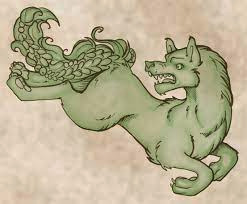
Hawk I haven't see much for, I think it's more present in Egypt and Norse mythology. Could tie it to history of falconry though I haven't much into it.
But those are the animals I know for sure could work and be tied to a Celtic Order or at least plausible if not for sure.
31 notes
·
View notes
Text
The gods of Gaul: Cernunnos
Cernunnos is without a doubt one of the most famous gods of Ancient Gaul, and yet he is actually one of the most mysterious Gallic deities. Sure, he definitively marked the imagination of people - I mean he was literaly used as the basis for the Wiccan Horned God, and you will see lots of Cernunnos-copycats in fantasy RPGs and the like. But... we actually do not know the truth about this god, and despite everybody on the Internet trying to make it sound like we have an easy and simple summary of what he is, we only have strong theories and conflicting hypothesis.
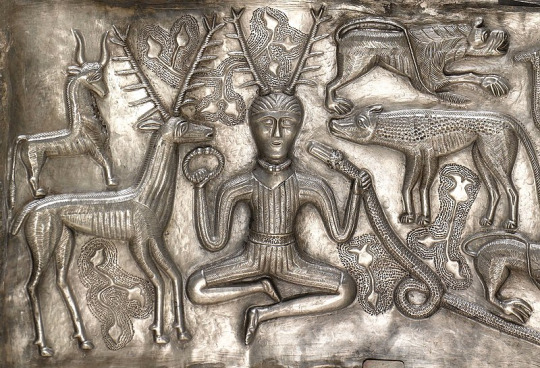
I/ What we actually have
As with a lot of Gallic gods, Cernunnos exists not in legends or myths, but through a name and a visual. The name Cernunnos is found three times all on its own in Gallic documents. One was a Greek inscription from Montagnac that only says "This is dedicated to Karnonos of Alisontia". The other two are identical inscriptions found in Luxemburg (near Steinsel), votive inscriptions of wish-offerings merely saying "Deo Ceruninco". There is actually a fourth inscripton of the name Cernunnos - and it is from this one that we get the spelling we use today - but it is a special one. Unlike the other three, this one has a picture alongside it identifying the god visually. It is the famous "pilier des Nautes" found under Notre-Dame-de-Paris, the "pillar of the Nautes", the "pillar of Boatmen", considered one of the most important Gallic monuments (because it depicts a set of divine portraits with their names explicitely spelled out).
It is only thanks to this pillar that we know today that the many depictions of a male horned god found across Gallic art are meant to be Cernunnos. There are too many visual depictions of him to be listed here (sixty or so were found by archeologists), but among the most famous is the one I put a picture of above: the Cernunnos of the Gundestrup cauldron found in Denmark.
Here is what Cernunnos looks like on the pilier des Nautes:
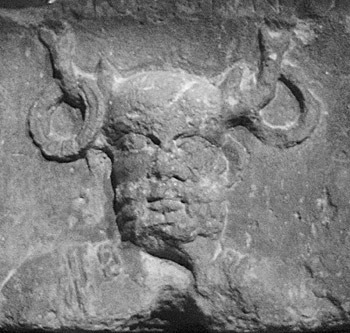
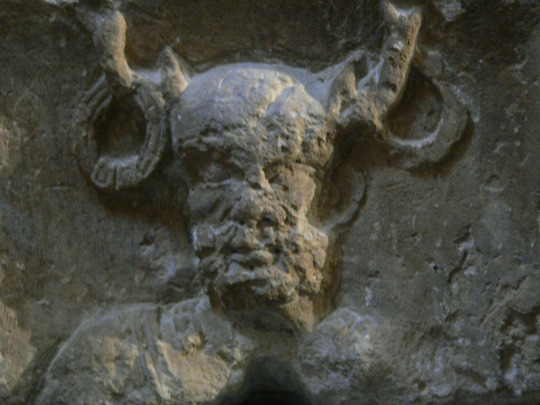

So, we have a name and a bunch of pictures. Let's try to break it all down.
When it comes to the name, Cernunnos/Karnonos, it is commonly agreed by etymologists and those that studied the Gallic language that it means "the horned god". "Carnon/Karnon/Karn" was known to mean "horn", both in the sense of animal's horn and a blowing instrument - it was tied to the Gallic tribes known as the Carni and Carnutes, and to the Celtic carnyx. The "kern" part is also considered to be equivalent to the Old Irish "cern", which was associated with horned beasts. Some have pointed out that if the "Cern" of "Cernunnos" means horn, the "unnos" could be a suffix meaning "beautifully" - so instead of Cernunnos being the "horned god" or the "horned one" it would mean "He who is beautifully horned" or "He with beautiful horns". But all in all, his name stays connected to horns.
[But is it truly his name? This is another debate typical with the gods of Gaul: we do not know the differences between the proper names, the titles and the nicknames. It could be (to take a Greek comparison) like Hestia's case, where he names literaly means "hearth" but is a proper name ; or it could be like the "Old Man of the Sea" which was a generic nickname for a whole group of sea deities.
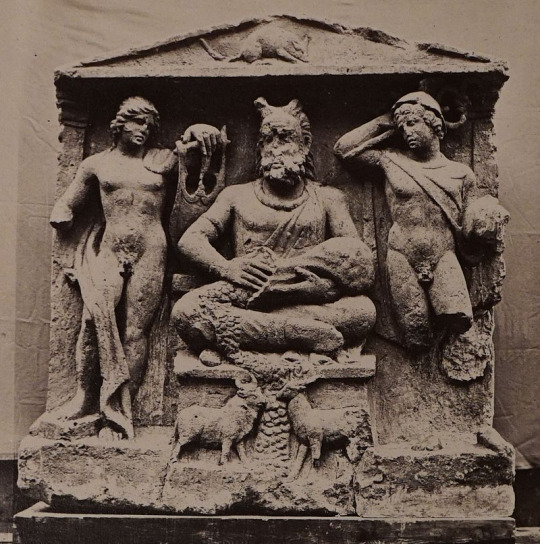
Now let's talk about the images of the god. Thanks to having so many depictions of him, we can identify recurring traits that define his visual.
Cernunnos always appears with his legs crossed, in a position (the "lotus" or "yoga positon" to take Asian terminology) that is considered, depending on the sources, either "very unusual for a god of Gaul", either "absolutely typical of Celtic representations of gods, warriors and heroes"... Well, he is almost always in the "lotus position" - in rare cases, he can be standing up. Cernunnos is also always wearing a torc, the traditional Gallic ornament, though he isn't always wearing it around his neck as one would expect: sometimes he holds it in his hands, other time it hangs from his antlers. Speaking of antlers: as we said, Cernunnos is a horned god, and he is usually depicted with antlers. But sometimes, more rarely, he rather sports goat horns - maybe it is a Romanization effect, as he got confused with Pan?
Cernunnos is always a male figure, though his actual age is unclear. Sometimes he is a mature and bearded man, but we also have "ephebe" depictions of him as a beardless youth - that some researchers even go as far as to describe as "child-like". Similarly, he keeps oscilatting between being a singular entity, and a triple-god with three heads or three faces. The disposition of the three faces can be really weird and freaky - for example, he can have a regular human head, and two small human faces growing from either side of his neck, or from the top of his head.
He usually always has a bag or basket with him, a bag that he eithers opens or that is simply sitting before him, spilling its content: sometimes the bag is filled with food, other times with coins, and other tims yet with grain. Cernunnos is usually sitting in the middle of a trio (as in two other humaoid or divine figures are by his side), or he is surrounded by various animals - which he can be seen holding with one hand, or petting near his lap. There are various animals he is associated with - we have seen him with stags, with bulls, with rats, with dogs, with lions, with goats... He is most notorious for being often depicted with the symbolic-mythical beast of Gaul known as the cryocephal snake: a ram-headed snake, whose exact meaning is still unclear to this day. However, Cernunnos seems to really like them: sometmes they just sit side by side, sometims he holds it by the throat, sometimes he feeds it, and other times two of them sit on his lap.

(This depiction above lacks any horns, but there are two holes at the top of the head implying that the horns were a different part of the statue added separately - which is very interesting in the theory of Cernunnos having antlers that "fall")
One of the problems with the Cernunnos visuals is that it is not clear where they stop, as we got a wide range of variations between the animal and the man. For example, there are strong theories according to which Cernunnos appears on the Strettweg chariot, as the tiny deer with oversized antlers that two men are holding (which would mean Cernunnos could be depicted as a full stag without human traits):
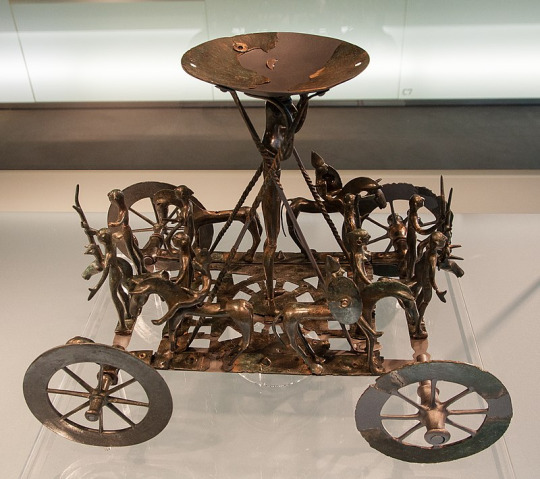
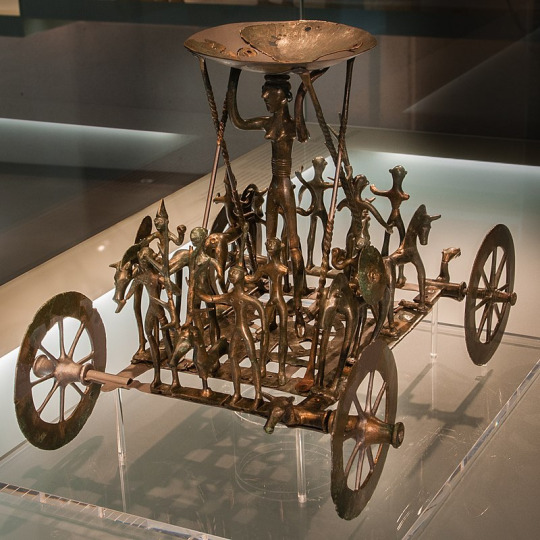
And on the opposite spectrum, a Gallo-Roman statue was found in Amiens of a fully human deity... except for one deer ear on the side of his face. One of the theories to explain this bizarre statue of the first century claims that it is an hyper-Romanized depiction of Cernunnos - though other theories do exist (for example, when the statue was discovered, it was originally believed to depict Midas, with a variation of the "donkey ear" punishment):

And you also have in Bouray a cross-legged god with deer legs rather than antlers or ears:


Given how "late" the visual depictions of the gods of Gaul was, and how the Romanization of Gaul strongly encouraged and favorized the depiction of deities as humanoids (to fit with the Greco-Roman deities), it is very likely that Cernunnos started as a divine stag, as fully animal, and then slowly, especially under the Roman influence, became more and more humanized... (There's also a fascinating case of antlered-goddesses at Clermont-Ferrand and Besançon, but that's for later).
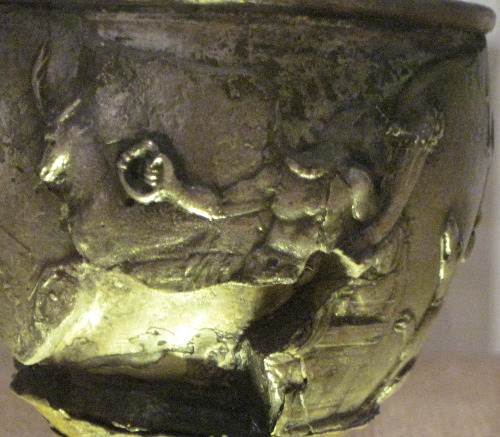
II/ Some theories
Now that we have the name and the visuals done... What's Cernunnos deal? Again remember we can only make theories based on these fragments and their context - but we do not know for certain if it is the truth.
A: It is agreed that Cernunnos is a nature god, and a god of abundance. The fact he is half-stag, and usually depicted with animals, and even holding them in a gesture of domination or use, shows that he is a fauna god, which prompted some researchers to identify him as one of the avatars of the "Lord of Animals, Master of Wild Things" archetype of Indo-European myths. But more importantly we are certain that he dealt with abundance and prosperity - thanks to him always having a big bag of grain, food or money. He was very clearly a god of riches and wealth - be them natural (grain, food) or manufactured (coins). Some have highlighted the idea that this tied to the symbolism of "forests that have big strong stags in them are bound to be fertile places filled with resources". Cernunnos' ties to abundance cannot be denied because in some Classicized depictions of him (such as the silver goblet above), he is literaly seen holding a cornucopia, aka a horn of abundance.
Some people even want to push the domain further by thinking Cernunnos might have been a god of sexual and reproductive fertility - but this is not based on any visual or religious clue. Rather this theory ties on the European symbolism of the stag as a symbol of virility and reproductive prowess, so it is a purely contextual reading, to be handled carefully. We are only truly certain that Cernunnos offered lots of money, lots of grain, lots of food, and lots of animals (him being surrounded by animals might be an extension of the "I offer you this bag of grain" visual, since animals were hunted down for food, so he isn't just a god of good crops and economic riches, but also one that ensures a plentiful hunt).
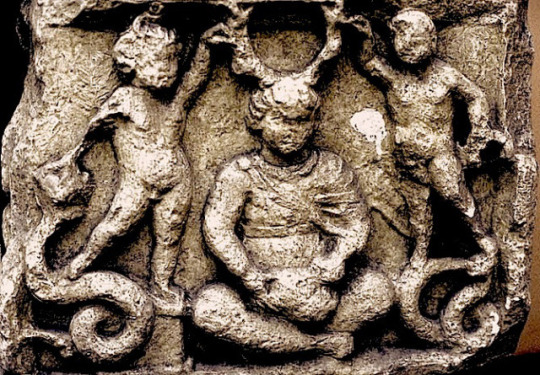
B: There is a strong theory going around that Cernunnos might be a seasonal god, or a deity of the seasonal cycle. This idea comes from various elements pieced together - and which added with the A theory above, would make this go a sort of "Father Nature" figure. It all starts wth the European symbolism of the antlers and the stag in general: given the antlers fall and grow with the turn of the seasons, the stag has been used heavily in Europe as a way to measure the year or symbolize seasons. Some researchers theorized, based on how the size of Cernunnos antlers changes through depictions, and on how he is sometimes a beardless youth sometimes a bearded mature man, that Cernunnos, like the stag, had a seasonal cycle. For some he just loses and grows back his antlers (there is a Cernunnos depiction at Meaux with what seems to be the stubs growing back after antlers fall, which would support this theory), but others push it further by claiming the god died and was reborn each year with winter/spring - an idea inspired by the Indo-European archetype of the dying/sacrifical vegetation god.
There is a specific depiction of Cernunnos that ties into this whole - and I will have to trust Yann Brekilen's word for this, as I couldn't find any picture of the engravings he described. According to him, on the Gallo-Roman Germanicus Arch/Arc, by Saintes, there is a dual depiction of Cernunnos. On one side of the Arch, he is part of a trio: he is sitting crossed-leg with antlers on his head, but naked (usually Cernunnos s clothed in some ways). By his side there is a man armed with a club/mace (which might be tied to the "god with the mace", we'll see that in later posts), and a woman holding a cornucopia. Now, that's on one side of the monument - but on the opposite side, the scene is reproduced... with both the armed man and the antlers of Cernunnos missing, only leaving a regular cross-legged naked man, and the cornucopia-woman. Speaking of this cornucopia-woman: there are repeated talks and interpretations of any female figure by Cernunnos' side to be a "Mother-Goddess" or Earth-Goddess supposed to be the wife/companion/lover of Cernunnos. This is all part of an effort to make Cernunnos a "father-god" (which makes sense in some ways), and it ties into the whole reading of his myth as being a seasonal cycle (the god dying and resurrecting after impregnating his female counterpart ; something the Wiccan mythology for example reused in their beliefs), but... If you ask me, I am not really convinced? A lot of people insist on there being a "Mother Goddess" clearly by Cernunnos' side, but sometimes you see these people reinterpret a lot of the visuals, and it is not obvious that the female figure is with him (Cernunnos is usually surrounded by male figures rather than female ones). Plus, we know the Mother Goddess of Gaul tended to come in three (the famous Matronae) so... I am a bit doubtful of that, but that's just me and because of a lack of convincing evidence.
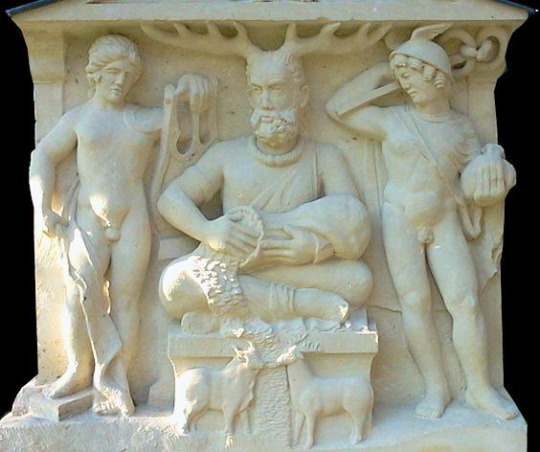
III/ Comparisons and equivalences
As I said in my introduction post, a lot of what we know about the Gallic gods comes from the syncretism the Romans operated with their own deities. And with Cernunnos it is... complicated. Because we do not know exactly who was the Roman equivalent of Cernunnos (since the Romans did not speak of him), and based on researches we have two likely candidates. It is very possible Cernunnos might have been split into those two Roman deities, or at least that his attributes led him to be interpreted as two deities mixed in one.
On one side, there is a very strong and popular theory that Cerunnos was the god Cesar, in his description of the religion of Gaul, called the "Dis Pater". "Dis Pater" was the Latin god that was equated and synthesized with the Greek Hades under the share nickname "Pluto", "the rich one". This was because Dis Pater was not originally a god of the dead in the old Italian religion - he was an underground god, indeed, but a chthonic god of riches and wealth, an earth-god of fertility (his very name meant "Rich Father"). This is what tied him to Hades, the richest of the Greek gods - and made him the new god of the underworld and the dead, Pluto. So, equating Dis Pater with Cernunnos makes sense as we do know that both deities were strongly associated with an earthly form of fertility: Cernunnos, just like Dis Pater, brought grain and earth-grown fruit, as well as precious metal (in the form of coins). Not only that, but Cernunnos was strongly associated with the ram-headed snake, and while we don't know much about this mythical being (typically a companion of male gods in Gallic art), it seems to have been a chthonian symbol, and perhaps even a form of guardian of the world of the dead (or a guardian of underground riches cousin of the dragons of legends). This is what led many to interpret Cernunnos as a chthonian deity, perhaps even an afterlife deity - a tradition that seems to have been in early Christian art, where Cernunnos was often associated with the "mouth of Hell" or the "entrance to Hades" (like the 9th century manuscript Stuttsgart Psalter, which illustrates Cernunnos in a depiction of the Christ descending into Limbo.
If Cernunnos is indeed Cesar's Dis Pater, then it would be extremely interesting, because Cesar wrote in his records that the peopleof Gaul believed Dis Pater to be their divine ancestor, and the "father of their race". Aka, the Gallic Dis Pater is meant to be an All-Father, the first ancestor of the Gallic tribes, and the origin of the human race (or at least of the people of Gaul). If Cernunnos is this Dis Pater, it would confirm his role as a "Father-God" and his links to a potential "Mother-Goddess". (It could also explain why he so persistantly wears a torc, as an emblem of the civilization and traditions of Gaul) If Cernunnos is also the Dis Pater, it would give him a role as a nocturnal god, since Cesar resumed in his texts (or rather "recaped" since he was doing a report based on Posidonius own records) that it was because the people of Gaul descended from Dis Pater that the druids measured the time not in "days" but in "nights"...
The other very likely candidate for the Romanized Cernunnos is the one we call the "Gallic Mercury". We know that Mercury was one of the most popular and widespread gods of Gallo-Roman gaul. Cesar did mention him as one of the most important gods venerated by the Gallic tribes before the omans arrive (though this would contadict the is Pater theory, since Cesar identifies Dis Pater and Mercury as two different deities in the Gallic beliefs). Still, Mercury was a god of commerce and riches before all - even more so than his Greek counterpart Hermes - so it makes sense that he would be present in the Gaul province of the Empire, which was big heart of commerce. And where Mercury has a pouch of coins, Cernunnos has a full bag of them... And in several Gallo-Romans depictions one of the two gods that surround Cernunnos is very obviously Mercury... [Several of the images in this post are of the altar of Reims, which depicts Cernunnos surrounded by Apollo on one side and Mercury on the other] And Cernunnos' presence on the Pillar of Boatmen implies he was tied to the fluvial sailors, and to the fluvial commerce and travels... And in Luxembourg we have Gallic depictions of stags vomitting coins, again insisting on how the stag was associated with riches... Even if you take Cernunnos as a chtonian god or death god, it ties to Mercury's role as a psychopomp inherited from Hermes ; and Mercury's presence by Cernunnos side on the altar of Reims for example makes sense if you consider one of the deities Cernunnos was conflated with was Pan (hence the goat horns) - aka, the son of Hermes... Everything is tied together into one big convoluted web of inter-mythologies.

And when it comes to comparisons to other Celtic mythologies, things are a bit... In French we say "vaseux" - basically there were parallels drawn between Cernunnos and Celtic figures of the Isles, but they rely on very meager if not unstable links. For example some have tried to identify the Cernunnos of Gaul with the Irish figure of Nemed (interpreted as a "stag-god" leading "stag-people" or "deer-people"), and in return the battle between Nemed and Balor for the land of Ireland was projected onto the scene depicted on the Arch that I described prior - a battle between the horned god and the god with the mace for the "earth-mother", the cornucopia woman, the land-goddess. The acceptance of this scene between the horned god and the mace god as a battle for the mother-goddess (which, I insist, was not PROVEN in any way and is completely hypothetic and theorized with no definitive proof - maybe the mace god is here to sacrifice the horned god for the cornucopia-woman, or maybe he is just here to cut off his antlers, or maybe the cornucopia woma cheats on Cernunnos wit the mace god, we cannot know), also led to vague comparisons being drawn to the story of Pwyll and Arawn and how they exchange each other's identities, but we are really in a stretch here.
More interestingly there is a Welsh comparison that could indicate a leftover of a Christianized Cernunnos in an Arthurian setting: the Owein tale (Mabinogi): Kynon, a knight of King Arthur's court, describes how in his youth he had to encounter an ugly knight clad in a black armor who had the information he needed to find his enemy. The knight lived by a "fountain" (a water stream) surrounded by wild and ferocious animals - and to give Kynon the information he needed, the ugly black knight struck a stag nearby, and the animal lowers its head in the direction Kynon must follow. It is very plausible that this supernatural knight who hits an informative stag and who lives surrounded by wild animals is a form of Christian censorship or caricature of a Cernunnos figure, going from a wise and benevolent stag-god to an ugly evil knight who abuses animals, and who has his duality human/beast split between the knight and the stag.
There were also tenuous elements that made people consider the Irish Conall Cernach (known for being one of the sidekicks of Cuchulainn) as a diluted version of Cernunnos as a "Master of Beasts" - more precisely an episode in "The Cattle Raid on Fraech" where instead of killing a monstrous snake, Conall somehow tames it and wears it as a belt, has been compared to Cernunnos' handling of snakes and ram-headed snakes. And don't even get me started on the many, MANY saints of Catholicism that are supposed to be leftovers or reinventions of Cernunnos (saint Ciaran of Saighir, because he tamed wild beasts including a stag ; or the saints of Bretagne Edern and Théleau both supposed to ride a stag instead of a horse...).
The complicated thing (well ONE of the complicated things) with Cernunnos is that he is tied to the stag, and the stag was one of the most prominent smbols and images of the medieval and proto-medieval imagery in Western Europe. You had lot of old mythology stuff that survived in modern days, but you also had lots of medieval symbolism and images (like how the flying stag was one of the symbols of the king of France), and a HUGE re-use of the stag by Christianity in various forms (from the antlers falling being used as a symbol of the Resurrection, to the hunt for the white otherwordly stag of Celtic myths suddenly becoming a hunt for Christ incarnate when a glowing cross appears above the stag's head...). As such it is hard to pin-point what the Gauls truly believed the stag meant, versus the stag symbolism that arose in the Middle-Ages.
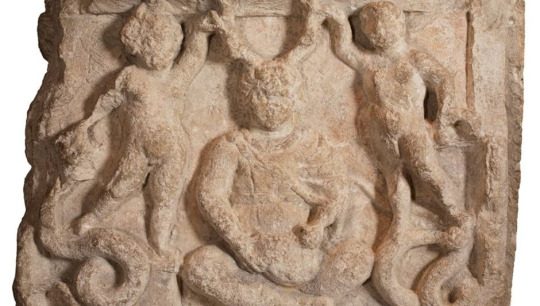
To conclude this post, while I said I had my doubts with systematic identifications of Cernunnos as a companion of a Mother-Goddess, I want to briefly return about a fascinating trivia of Gallic researches: the existence of a female version of Cernunnos, a "Cernunna" we could jokingly say.
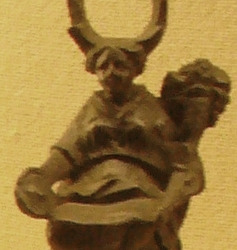
Little figurines and statues were found of a horned goddess - sometimes with antlers! - in both the area of Clermont-Ferrand (which was the domain of the Avernes folk) and around Besançon (the Séquane folk). Who were these goddesses? Local variations of Cernunnos? Sisters, daughters or wives of the god? Or completely unrelated deities? Were they one or several (some are more matronly, motherly figures such as the one with antlers above, others have Venus-like poses unveiling their breast and legs such as the bull-horned below)?
We will probably never know - but while they can be incarnations of this famed "Mother-Goddess" companion of Cernunnos everybody speaks about (and links to the importation of the cults of Demeter and Cybele in Gaul), it is VERY likely these statues date from the Gallo-Roman era and from a Romanized version of the Gallic religion. Indeed, they are all tied by their attributes - they hold a cornucopia, and a "patère" (sacred vase for religious libations). Attributes present in very Romanized Gallic goddesses (such as Rosmerta), but also in typical Roman deities (mainly the lares). Add to that how the adjunction of a male attribute (the stag antlers or bull horns) to a female figure is VERY unusual for Gallic depictions (where the genders are neatly split), while the divine androgyny was a feature of Greco-Roman mythology (the effeminate Apollo and Dionysos, the masculine goddesses Athena and Artemis, the mythical Hermaphrodite...), and it is very likely these statues of the "Cernunna" are the result of the Roman religion "breeding" with the Gallic beliefs...
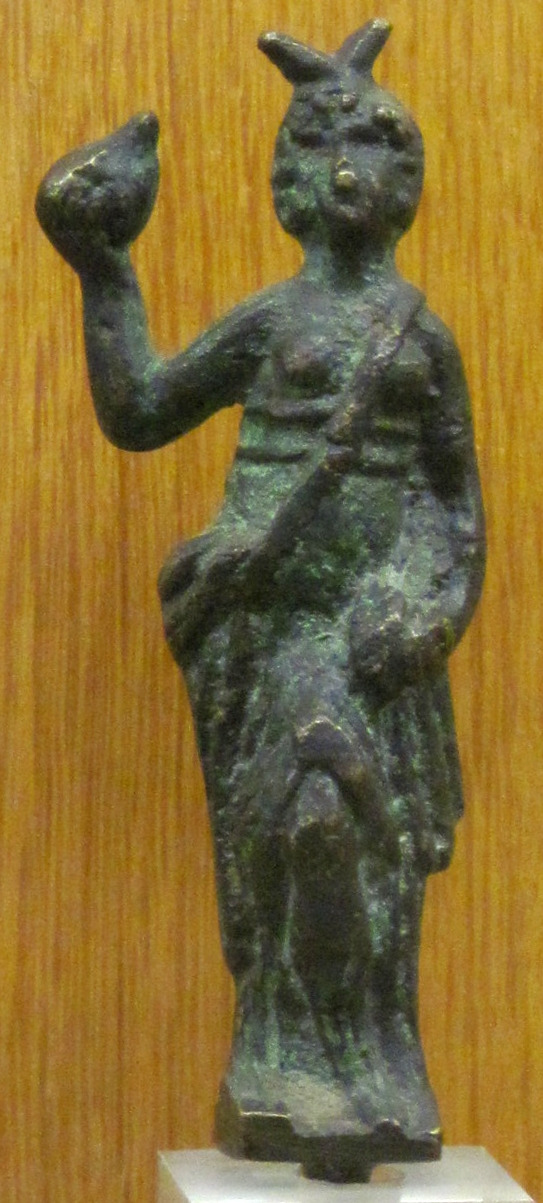
#gods of gaul#gallic mythology#cernunnos#ancient gaul#religion of gaul#gallic religion#gallic gods#gallic goddesses
126 notes
·
View notes
Text
CENTRAL & SOUTH EUROPEAN RESOURCES
The Anthropological Masterlist is HERE.
Central Europe is a European region that is between West Europe and East Europe. The region has influence from both West and East Europe due to its position and history.
CROATIA ─ “The Croatian people are a Central European people that share the Croatian culture. They are native to Croatia.”
─ Croatian Art
─ Croatian History
─ Serbo-Croatian Dictionary
HELVETII ─ “The Helvetii, or Helvetians, were a Celtic people that lived until the 1st century B.C.E. They lived in the Swiss plateau.”
─ Swiss Celts (in German)
─ Commentary on the Gallic Wars
ROMANI ─ “The Romani, or Rromani, people are a nomadic Indo-Aryan people. They are most likely native to India.”
─ Romani Culture & History
─ Romani Mythology
─ Romani Dictionary
SWITZERLAND ─ “The Swiss people are a European people that share the Swiss culture. They are native to Switzerland.”
─ Swiss Information
─ Swiss History
─ Romansh Dictionary
South Europe, or Mediterranean Europe, is a European region that is underneath West Europe. It borders the Mediterranean Sea.
ALBANIA ─ “The Albanians are a Balkan people. They are native to the Balkan Peninsula and share Albanian culture.”
─ Albanian Folklore
─ Albanian History
─ Albanian Language
BASQUE ─ “The Basques are a Southwestern European people. They are native to the Basque Country in Spain and France.”
─ Basque Information
─ Basque Resources
─ Basque Language
CANTABRIA ─ “The Cantabrians, or Cantabri, were a Celtic people. They lived in northern Iberia.”
─ Cantabrian Wars (in Spanish)
─ Cantabrian Mythology (in Spanish)
CELTIBERIA ─ “The Celtiberians were a Celtic people. They lived in the Iberian Peninsula.”
─ Celtiberian Information
GREECE ─ “The Ancient Greeks were a Mediterranean people that lived from the 8th century B.C.E. to the 7th century C.E. They lived in modern-day Greece and the western coast of Turkey.”
─ Ancient Greek Philosophy
─ Greek History
─ Greek Mythology
LUSITANIA ─ “The Lusitanians were an Indo-European people. They lived in the western Iberian Peninsula before Romanization.”
─ Lusitanians in Iberia
─ Lusitanian Language
MINOA ─ “The Minoan civilization was a Mediterranean civilization that lived from 3500 B.C.E. to 1100 B.C.E. They lived in the Aegean Islands.”
─ Minoan History
─ Cretan Mythology
─ Minoan Clothing
#resources#central europe#southern europe#croatia#helvetii#romani#switzerland#basque#cantabria#celtiberia#greece#lusitania#minoa
45 notes
·
View notes
Text
Digital Altar: Cernunnos
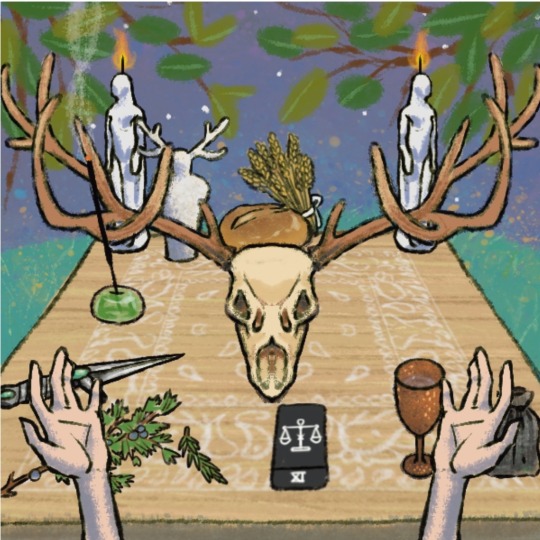
Gaulish God of liminality, death, mediation, balance, wealth, the hunt, and the wild & tamed.
#deities#pagan#polytheism#polytheist#deity#paganism#gaulish polytheism#altar#digital altar#E-shrine#cernunnos#the horned god#the horned one#karnonos#Gaulish Deities#Gallic Gods#mythology#gaulpol#occult#occultism#piccrew#devotional#offerings#godspouses#godspouse#godpartner#godspousing#godconsort#broom closet#celtic polytheism
92 notes
·
View notes
Text
hello =^^= !! my name is spencer (any/all pronouns). i’m a louisiana cajun, 17, AuDHD, and queer! — @hornedtrixtr @etherealarrows
hellenic polytheist, sophian & ophite gnostic, theistic luciferian, and animist.
beginner ancestral worker, spiritual alchemist, french and gallic folk practitioner.
interests: kmusic, philosophy, ancient history, linguistics, mythology and theology, anthropology, reading and writing, nature, tv shows supernatural and criminal minds, twilight movies, minecraft and overwatch, and politics.
please keep in mind that i am still learning! if i say or do something that is disrespectful or incorrect, please let me know.
i absolutely love making friends and talking to people so please feel free to send me an ask or dm me! i’m open to giving out my socials to those i trust! my blog is an entirely safe space.
dni: bigot or oppressor of any kind. endo, map, ageplay, pro-ana/mia blogs, anti-recovery, etc. gentile lilith worshipper. disrespects closed practices. includes people who support any of this. also, if you named yourself after a deity, deified mortal, angel, demon, or important mythological figure. if it’s your given name then that’s okay.
my general rule of thumb: if you make me uncomfortable, i’ll block you.

11 notes
·
View notes
Text
#unhallowedarts "Try to be Civil, Marlow" - Joseph Conrad's "Heart of Darkness"

“We live as we dream--alone....” (Joseph Conrad)
He did turn fresh-water sailor himself once, after sailing the seven seas for 15 years, finally making “master” on the barque “Otago” of the British Merchant Navy, carrying goods on the South Australia run back in the late 1880s. The Polish-born skipper of a riverboat steaming up the Lualaba towards the Belgian government station at Kisangani below the Stanley Falls found the grave and the tale of a bad white man gone to worse in Central Africa, in the hell of King Leopold II’s so called Congo Free State. It might be that the aspiring author had heard the enthralling voice of Mr Kurtz there for the first time. Almost a decade later, when the jolly tar brought his experiences to paper, the voice had received the superstructure of a Nietzschean Übermensch, the psychological abyss of Dostoevsky’s outré protagonists and Captain Ahab’s hubris. A man who founders in the Heart of Darkness, the distorting mirror Africa had become for Europe’s cloud-cuckoo-land at the end of the long 19th century. The only remedy against things falling apart, the centre that just might hold, were the seamannish virtues of the tale’s narrator, idealised by its author, Joseph Conrad. But Conrad always was a novelist who went to sea instead of a seaman who became an author.

Many of Conrad’s tales might look like tarry, rough handed sailors at first acquaintance, but they soon take on the guise of Marlow, his narrator oftimes, sitting on deck of the Nellie riding at anchor in Gravesend, spinning his yarn, with “sunken cheeks, a yellow complexion, a straight back, an ascetic aspect, and, with his arms dropped, the palms of hands outwards,” resembling “a Buddha preaching in European clothes and without a lotus-flower. And no balm in Gilead either. “Heart of Darkness” barrages the reader with imagery from Dante to the more sinister aspects of Greek mythology along with the cold and lofty heights of contemporary European literature. A climate no one escapes alive. Or at least not sane. “He cried in a whisper at some image, at some vision—he cried out twice, a cry that was no more than a breath:
“‘The horror! The horror!’”
But then, Conrad’s Africa is a distorting mirror all by itself and the novelette is not so much describing things as they were – even though Conrad manages to do that well enough. The “Heart of Darkness” is not discovered in foreign climes but too close for comfort and travelling on an actual river might never be the same after reading Conrad, the tale told is a Campbellian journey inwards.
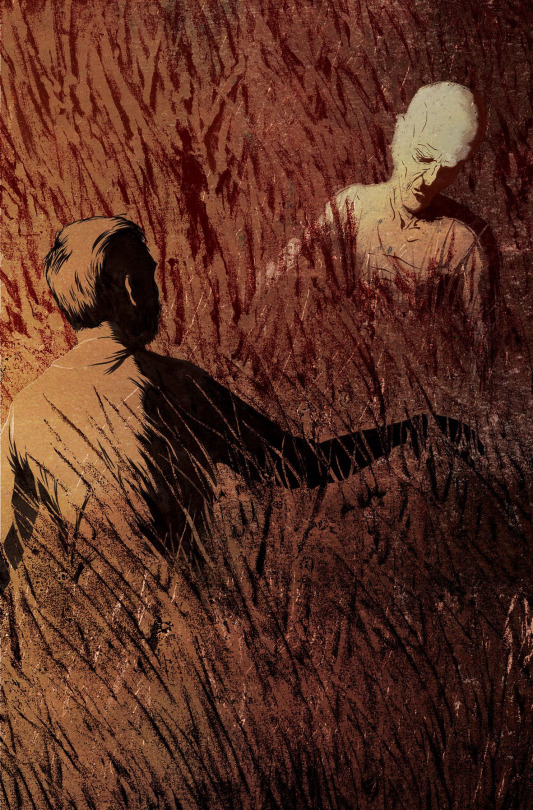
He indulged himself in the abyss of the human soul, seen and heard in Conrad’s work, but very rarely voiced in single arias with all highs and lows, standing out from the choir of highly polyphonic arrangements, like Dostoevsky’s. It’s a horror, and that’s that. With a surprisingly simple remedy: “Try to be civil, Marlow“, despite the tragédie humaine Conrad usually narrates. And while his matchless prose with all its Gallicisms, Polonisms and artificially wonderful word and grammar structures and creations no native speaker could come up with remains unrivalled, his influence, at the very least through his rich imagery. Seen and distorted into Symbolist visions, garnished with enchanting, often disturbing and sometimes misleading adjectives, a realist author with a very, very deep cargo hold.
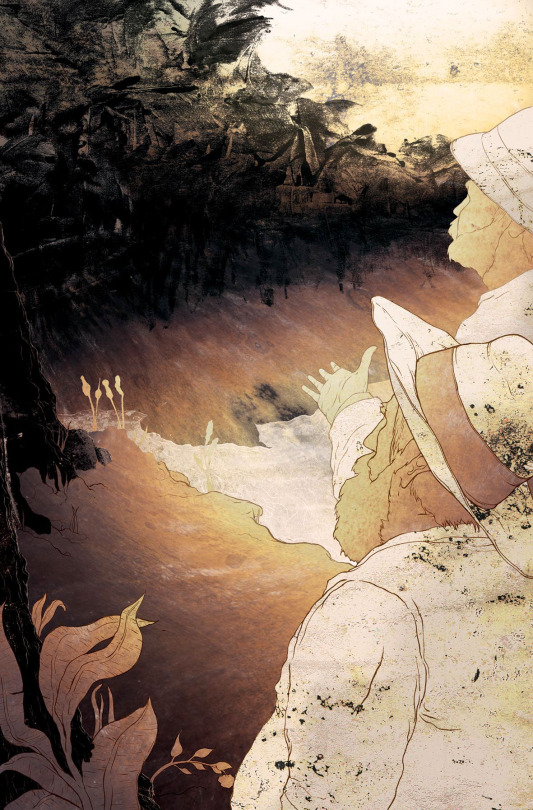
All images above were created by Sean McSorley for the Folio Society's 2014 edition of Joseph Conrad's "Heart of Darkness", a gem that can be acquired following the link below - and where McSorley excellent - and quite congenial - artwork was nicked from.
#unhallowedarts#dark literature#dark aesthetic#classic fiction#classic literature#joseph conrad#heart of darkness
9 notes
·
View notes
Photo

62 new moons for Saturn The work of an international team of astronomers has resulted in the announcement of 62 new moons of Saturn, catapulting it back into first place of the "moon race" around the giant planets of our solar system. The team is led by Edward Ashton (currently a postdoctoral fellow at Taiwan's Academia Sinica Institute of Astronomy and Astrophysics) and includes professor Brett Gladman (Department of Physics & Astronomy at the University of British Columbia), Mike Alexandersen (Harvard Smithsonian Center for Astrophysics), Jean-Marc Petit (Observatoire de Besancon), and Matthew Beaudoin (University of British Columbia). Over the past two decades, Saturn's surroundings have been repeatedly examined for moons with increasing sensitivity. In this latest study, Dr. Ashton's team used a technique known as "shift and stack" in order to find fainter (and thus smaller) saturnian moons. This method has been used for moon searches around Neptune and Uranus, but never for Saturn. Shifting a set of sequential images at the rate that the moon is moving across the sky results in enhancement of the moon's signal when all the data is combined, allowing moons that were too faint to be seen in individual images to become visible in the "stacked" image. The team used data taken using the Canada-France-Hawaii Telescope (CFHT) on top of Mauna Kea, Hawaii between 2019 and 2021. By shifting and stacking many sequential images taken during 3 hour spans, they were able to detect moons of Saturn down to about 2.5 kilometers in diameter. The original discovery search was done in 2019 when Ashton and Beaudoin were students at the University of British Columbia, uncovering the moons in a meticulous search of the deep CFHT imaging acquired that year. But just finding an object close to Saturn on the sky is insufficient to say for certain that it is a moon; it could in principle be an asteroid that just happened to be passing close to the planet (although this is unlikely). To be absolutely sure, the object must be tracked for several years before one can establish that it is certainly orbiting the planet. After painstakingly matching objects detected on different nights over two years, the team has managed to track 63 objects, thus confirming them as new moons. One of the new moons, designated S/2019 S 1, was announced back in 2021, with the rest being announced over the last couple of weeks. Some of the team's linked orbits were identified with past observations from many years ago that briefly glimpsed some of these moons (but were not tracked long enough to establish their orbit around Saturn). "Tracking these moons makes me recall playing the kid's game Dot-to-Dot, because we have to connect the various appearances of these moons in our data with a viable orbit," explains Edward Ashton, "but with about 100 different games on the same page and you don't know which dot belongs to which puzzle." All of the new moons are in the class of irregular moons, which are thought to be initially captured by their host planet long ago. Irregular moons are characterized by their large, elliptical, and inclined orbits compared to regular moons. The number of known saturnian irregular moons has more than doubled to 121, with 58 previously known before the search began. Including the 24 regular moons, there is now a total of 145 recognized (by the International Astronomical Union) moons orbiting Saturn. The new discoveries have resulted in multiple milestones for the ringed planet. Saturn has not only regained its crown for having the most known moons (overtaking Jupiter with 95 recognized moons), it is also the first planet to have over 100 discovered moons in total. The irregular moons tend to clump together into orbital groups based on the tilt of their orbits. In the saturnian system there are 3 such groups whose names are drawn from different mythologies: there is the Inuit group, the Gallic group, and the much more populated Norse group. For example, three new discoveries fall in the Inuit group: S/2019 S 1, S/2020 S 1 and S/2005 S 4 have very small orbits tilted similarly to that of the previously known larger irregulars Kiviuq and Ijiraq. All of the new moons fall into one of the three known groups, with the Norse group again being the most populated among the new moons. The groups are thought to be the result of collisions, where the current moons in a group are remnants of one or more collisions on the originally-captured moons. A better understanding of the orbital distribution thus provides insight into the collisional history of the irregular moon system of Saturn. Based on their past studies of these moons, this team has suggested that the large number of small moons on retrograde orbits is the result of a relatively recent (in astronomical terms, being in the last 100 million years) disruption of a moderately sized irregular moon that is now broken into the many fragments that are being catalogued in the Norse group. As professor Gladman explains, "as one pushes to the limit of modern telescopes, we are finding increasing evidence that a moderate-sized moon orbiting backwards around Saturn was blown apart something like 100 million years ago." IMAGE....The paths of four of the new moons as they orbit Saturn (black circle at center) during the period 2019-2021. The colored dots mark the observed position for each moon; the dashed curve shows the orbit that connects them. Credit: University of British Columbia
5 notes
·
View notes